A Comprehensive Review of the Current Knowledge of Chlorfenapyr: Synthesis, Mode of Action, Resistance, and Environmental Toxicology
Abstract
:1. Introduction
2. Discovery of Chlorfenapyr
3. Synthesis of Chlorfenapyr and Its Derivatives
3.1. Chlorfenapyr
3.2. Chlorfenapyr Derivatives
3.2.1. N-Substituted Derivatives
3.2.2. Aryl-Substituted Derivatives
3.2.3. 5-Position-Substituted Derivatives
3.2.4. Other Positions Substituted in the Pyrrole Ring
3.2.5. Amino Acid Chlorfenapyr Conjugate
3.2.6. N-Bridged Chlorfenapyr Derivatives
3.3. Structure Activity Relationship
4. Mode of Action of Chlorfenapyr
5. Resistance of Chlorfenapyr
6. Environmental Toxicology of Chlorfenapyr
7. Conclusions
Author Contributions
Funding
Institutional Review Board Statement
Informed Consent Statement
Data Availability Statement
Conflicts of Interest
References
- He, X.; Lu, L.; Huang, P.; Yu, B.; Peng, L.; Zou, L.; Ren, Y. Insect cell-based models cell line establishment and application in insecticide screening and toxicology research. Insects 2023, 14, 104. [Google Scholar] [CrossRef] [PubMed]
- Brown, D.G.; Siddens, J.K.; Diehl, R.E.; Wright, D.P. Arylpyrrole Insecticidal Acaricidal and Nematicidal Agents and Methods for the Preparation. U.S. Patent 5,010,098, 23 April 1991. [Google Scholar]
- Ren, Y.; He, L.; Jin, H.; Jin, H.; Tao, K.; Hou, T.P. Cytotoxicity evaluation and apoptosis-inducing effects of furanone analogues in insect cell line SL2. Food Agric. Immunol. 2018, 29, 964–975. [Google Scholar] [CrossRef]
- Zhao, X.M.; Zhang, Y.F.; Chen, L.; Ma, Z.Q.; Zhang, B. Chitosan-thymol nanoparticle with pH responsiveness as a potential intelligent botanical fungicide against Botrytis cinerea. Pestic. Biochem. Physiol. 2023, 195, 105571. [Google Scholar] [CrossRef] [PubMed]
- Ren, Y.; Yang, N.; Yue, Y.; Jin, H.; Tao, K.; Hou, T.P. Investigation of novel pyrazole carboxamides as new apoptosis inducers on neuronal cells in Helicoverpa zea. Bioorg. Med. Chem. 2018, 26, 2280–2286. [Google Scholar] [CrossRef] [PubMed]
- Ren, Y.H.; Jin, H.; Tao, K.; Hou, T.P. Apoptotic effects of 1, 5-bis-(5-nitro-2-furanyl)-1, 4-pentadien-3-one on Drosophila SL2 cells. Mol. Cell. Toxicol. 2015, 11, 187–192. [Google Scholar] [CrossRef]
- Sharma, S.; Sahu, B.K.; Cao, L.D.; Bindra, P.; Kaur, K.; Chandel, M.; Koratkar, N.; Huang, Q.L.; Shanmugam, V. Porous nanomaterials: Main vein of agricultural nanotechnology. Prog. Mater. Sci. 2021, 121, 100812. [Google Scholar] [CrossRef]
- Ren, Y.; Li, Q.; Lu, L.; Jin, H.; Tao, K.; Hou, T.P. Isochamaejasmin induces toxic effects on Helicoverpa zea via DNA damage and mitochondria-associated apoptosis. Pest Manag. Sci. 2021, 77, 557–567. [Google Scholar] [CrossRef] [PubMed]
- Ren, Y.; Li, Q.; Lu, L.; Jin, H.; Tao, K.; Hou, T.P. Toxicity and physiological actions of biflavones on potassium current in insect neuronal cells. Pestic. Biochem. Physiol. 2021, 171, 104735. [Google Scholar] [CrossRef]
- Ren, Y.; Shi, J.; Mu, Y.; Tao, K.; Jin, H.; Hou, T.P. AW1 neuronal cell cytotoxicity: The mode of action of insecticidal fatty acids. J. Agric. Food Chem. 2019, 67, 12129–12136. [Google Scholar] [CrossRef]
- Ren, Y.; Mu, Y.; Yue, Y.; Jin, H.; Tao, K.; Hou, T. P. Neochamaejasmin A extracted from Stellera chamaejasme L. induces apoptosis involving mitochondrial dysfunction and oxidative stress in Sf9 cells. Pestic. Biochem. Physiol. 2019, 157, 169–177. [Google Scholar] [CrossRef]
- Sparangis, P.; Rumbos, C.I.; Tsiropoulos, N.G.; Athanassiou, C.G. Insecticidal and residual effect of chlorfenapyr on different surfaces for the control of Sitophilus oryzae. J. Stored Prod. Res. 2023, 103, 102153. [Google Scholar] [CrossRef]
- Chen, D.X.; Gong, J.H.; He, L.; Yang, Y.L.; Wang, P.; Fang, G.R.; Wang, C.D.; Chen, S.X. Research progress on extraction and applicationg of nicotine. Guangzhou Chem. Ind. 2021, 49, 1–4. [Google Scholar]
- Xu, H.H.; Huang, J.G. Advances in the researth of rotenone. J. Southwest Agric. Univ. 2001, 140–143. [Google Scholar]
- Huang, D.M.; Shi, D.N.; Li, D.X.; Tian, M.; Guo, X. Preliminary study on insecticidal activity of derris trifoliate extract against Megualurothrips usitatus. For. Environ. Sci. 2020, 36, 71–74. [Google Scholar]
- Zhou, W.S. Marine toxins. Org. Chem. 1984, 193–197. [Google Scholar]
- Wang, Y. Design and Synthesis, Evalution of Fungicidal Activity and Mechanism of Action of Novel Pyrazole-Pyridine Molecules; Hebei Agricultural University: Baoding, China, 2023. [Google Scholar]
- Fang, M. Development of 20.3% Emamectin Benzoate·Chlorfenapyr Dry Flowable for Controlling Spodoptera frugiperda; Sichuan Agricultural University: Ya’an, China, 2022. [Google Scholar]
- Xie, H.J. Stereoscopic Control Methods for Kiwifruit Canker Disease; Horticulture Research Institute of Sichuan Academy of Agricultural Sciences: Chengdu, China, 2015. [Google Scholar]
- Tian, F.J. Study on Resistance and Mechanism of Asian citrus psyllid, Diaphorina citri to Imidacloprid; South China Agricultural University: Guangzhou, China, 2022. [Google Scholar]
- Pei, H.; Ou, X.M.; Wang, Y.J.; Yu, K.; Lin, X.M. Toxicity and mode of action of chlorfenapyr against insects. Mod. Agrochem. 2006, 5, 33–35. [Google Scholar]
- Black, B.C.; Hollingworth, R.M.; Ahammadsahib, K.I.; Kukel, C.D.; Donovan, S. Insecticidal action and mitochondrial uncoupling activity of AC-303,630 and related halogenated pyrroles. Pestic. Biochem. Physiol. 1994, 50, 115–128. [Google Scholar] [CrossRef]
- Yang, J.C.; Dai, R.H.; Liu, Y.P.; Wu, Q.; Liu, C.L. Recent advance and synthesis on pesticides of pyridine series. Pesticide 2011, 50, 625–629+648. [Google Scholar]
- Wang, X.; Martínez, M.A.; Wu, Q.; Ares, I.; Martínez-Larrañaga, M.R.; Anadón, A.; Yuan, Z. Fipronil insecticide toxicology: Oxidative stress and metabolism. Crit. Rev. Toxicol. 2016, 46, 876–899. [Google Scholar] [CrossRef]
- Pachlatko, J.P. Natural Products in Crop Protction. In Proceedings of the 2nd International Electronic Conference on Synthetic Organic Chemistry, Online, 1–30 September 1998. [Google Scholar]
- Ligon, J.M.; Hill, D.S.; Hammer, P.E.; Torkewitz, N.R.; Hofmann, D.; Kempf, H.J.; Pée, K.H. Natural products with antifungal activity from Pseudomonas biocontrol bacteria. Pest Manag. Sci. Former. Pestic. Sci. 2000, 56, 688–695. [Google Scholar] [CrossRef]
- Ruan, L. Discovery and review of pyrrole insecticides. Pestic. Transl. 1995, 24–31. [Google Scholar]
- Addor, R.W.; Babcock, T.J.; Black, B.; Brown, D.G.; Diehl, R.E.; Furch, J.A.; Kameswaran, V.; Kanhi, V.M.; Kremer, K.A.; Kuhn, D.G.; et al. Insecticidal pyrroles: Discovery and overview. In Synthesis and Chemistry of Agrochemicals III; ACS Publication: Washington, DC, USA, 1992; pp. 283–297. [Google Scholar]
- Zhao, Y.; Mao, C.; Li, Y.; Zhang, P.; Huang, Z.; Bi, F.; Huang, R.; Wang, Q. Synthesis, crystal structure, and insecticidal activity of novel N-alkyloxyoxalyl derivatives of 2-arylpyrrole. J. Agric. Food Chem. 2008, 56, 7326–7332. [Google Scholar] [CrossRef] [PubMed]
- Xu, S.C.; Jiang, M.G. Research & development of chlorfenapyr. Pesticide 2003, 5–8. [Google Scholar]
- Ma, Q.Q.; Liu, Y.X.; Zhang, P.X.; Li, Y.Q.; Xiong, L.X.; Wang, Q.M. Design, synthesis, and biological evaluation of various alpha-substituted benzylpyrroles based on the structures of insecticidal chlorfenapyr and natural pyrrolomycins. J. Agric. Food Chem. 2014, 62, 6072–6081. [Google Scholar] [CrossRef] [PubMed]
- Wang, Z.J.; Wang, J.C.; Liu, X.L.; Wang, X.F.; Luo, R.S. Production Process of a Mixed Catalyst for Catalytic Synthesis of Imidacloprid. CN 110218170A, 10 September 2019. [Google Scholar]
- Robert, F.D.; Jerry, M.B. Alkoxymethylation of Pyrroles. U.S. Patent 5,359,090A, 25 October 1994. [Google Scholar]
- Ding, P.J.; Ni, J.F.; Zhao, S.X. A Synthesis Method of Bromfenitrile. CN 116082211A, 9 May 2023. [Google Scholar]
- Dai, J.L.; Chen, M.Y.; Xiang, W.Q.; Zhang, Y.Y.; Zhao, W.J. Progress in the synthesis of chlorfenapyr intermediate 2-(4-chlorophenyl)-5-(trifluoromethyl)-1h-pyrrole-3-carbonitrile. Organo-Fluor. Ind. 2019, 45–49. [Google Scholar]
- Xu, S.C.; Jiang, M.G.; Yu, Y.F.; Wang, X.J.; Wan, Q.; Xu, Z.Z. Synthesis of insecticide chlorfenapyr. J. Nanjing Agric. Univ. 2004, 27, 105–108. [Google Scholar]
- Fu, Q.; Zhang, X.M.; Yao, W.; Kong, X.L.; Lu, Q. Synthesis of chlorfenapyr. Agrochemicals 2006, 385–386+391. [Google Scholar]
- Herman, R.A.; Kukel, C.F. Method of Bait Compositions for Controlling Mollusks. EP 312723, 26 April 1989. [Google Scholar]
- Froyd, J.D.; Simith, D.B. Method of Controlling Phytopathogenic Fungi. EP 358047, 14 March 1990. [Google Scholar]
- Kameswaran, V.; Doehner, R.F., Jr.; Barton, J.M.; George, K.D. 2-aryl-5-(trifluoromethyl)-2-pyrroline Compounds and Process for the Manufacture of Insecticidal, 2-aryl-1-(alkoxymethyl)-4-halo-5-(trifluoromethyl) Pyrroles. EP 492171, 1 July 1992. [Google Scholar]
- Kameswaran, V. Synthesis of 2-aryl-5-(trifluoromethyl) Pyrroles Useful as Pesticidal Agents and as Intermediates for the Preparation of Said Agents. U.S. Patent 5,128,485, 7 July 1992. [Google Scholar]
- Kameswaran, V. Process for the Prepapation of Insecticidalnematicidal and Acaricidal 4-substituted-5-(trifluoro-methyl)-pyrrole-3-carbonitrile Compounds. U.S. Patent 5,106,985, 21 April 1992. [Google Scholar]
- Lu, Y.; Li, C.; Tao, J. New Synthesis Method for a new arylpyrrole insecticide chlorfenapyr. Mod. Agrochem. 2007, 6, 22. [Google Scholar]
- Lu, Y.; Li, C.R.; Tao, J.C.; Zhang, Z.R.; Xu, G.H.; Zhang, J. New synthesis method for arylpyrrole insecticide chlorfenapyr. Chem. Technol. Dev. 2007, 8–11. [Google Scholar]
- Cheng, Y.N.; Xie, G.Y.; Sun, S.J.; You, X.F. New method for synthesis of chlorfenapyr. Pesticide 2010, 560–562+580. [Google Scholar]
- Kameswaran, V. Process for the Preparation of 2-aryl-5-(perfluoroalkyl) pyrrole Compounds from N-(perfluoro-alkylmethyl) Arylimidoyl Chloride Compounds. U.S. Patent 5,965,773, 12 October 1999. [Google Scholar]
- Kameswaran, V. Process for the Preparation of 2-aryl-5-(perfluoro-alkyl) pyrrole Compounds from N-(perfluo-roalkyl-methyl) Arylimidoyl Chloride Compounds. U.S. Patent 5,817,834, 6 October 1998. [Google Scholar]
- Kameswaran, V. Process for the Preparation of Insecticidal, Acaricidal and Nematicidal 2-aryl-3-substituted-5-(trifluoromethyl) Pyrrole Compounds. U.S. Patent 5,225,568, 6 July 1993. [Google Scholar]
- Kameswaran, V. Process for the Manufacture of 2-aryl-5 Perfluoroalkylpyrrole Derivatives. U.S. Patent 5,777,132, 7 July 1998. [Google Scholar]
- Sun, G.Q.; Lu, Y.T. Mechanism, application and developmental future of chlorfenapyr. Anhui Agric. Sci. Bull. 2007, 13, 69–71. [Google Scholar]
- Hong, T.W.; Jimenez, D.R.; Molinski, T.F. Agelastatins C and D, new pentacyclic bromopyrrolrs from the Sponge Cymbastela sp.; and potent aryhropod toxicity of(-)-agelastain a. J. Nat. Prod. 1998, 61, 15–161. [Google Scholar] [CrossRef] [PubMed]
- Zhao, Y.; Li, Y.; Ou, X.; Zhang, P.; Huang, Z.; Bi, F.; Huang, R.; Wang, Q. Synthesis, insecticidal, and acaricidal activities of novel 2-aryl-pyrrole derivatives containing ester groups. J. Agric. Food Chem. 2008, 56, 10176–10182. [Google Scholar] [CrossRef] [PubMed]
- Wang, T.T.; Zhang, C.N. Effects of chlorfenapyr on detoxifying enzyme activities of diamondback moth, Plutella xylostella. Acta Agric. Boreali-Occident. Sin. 2014, 23, 196–200. [Google Scholar]
- Li, R.J.; Wang, K.Y.; Xia, X.M. Resistance selection by meilingmycin and chlorfenapyr and activity changes of detoxicated enzymes in Tetranychus urticae. J. Plant Prot. 2005, 32, 309–313. [Google Scholar]
- Ahmad, M.; Hollingworth, R.M. Synergism of insecticides provides evidence of metabolic mechanisms of resistance in the obliquebanded leafroller choristoneura rosaceana (Lepidotera: Tortricidae). Pest Manag. Sci. Former. Pestic. Sci. 2004, 65, 465–473. [Google Scholar] [CrossRef] [PubMed]
- Ahmad, M.; Arif, M. Resistance of Pakistani field populations of spotted bollworm Earias vittella (Lepidotera: Noctuidae) to pyrethroid, organophosphorus and new chemical insecticides. Pest Manag. Sci. Former. Pestic. Sci. 2009, 65, 433–439. [Google Scholar] [CrossRef] [PubMed]
- Uhr, H.; Marhold, A.; Andres, P.; Erdelen, C.; Wachendorff-Neumann, U.; Stendel, W. Substituted 2-arylpyrroles. U.S. Patent 5,233,051, 3 August 1993. [Google Scholar]
- Barnes, K.D.; Hu, Y.; Diehl, R.E.; Kamhi, V.M. Insecticidal 2-aryl-5-haloalkylthio-sulfinyl-, and sulfonylpyrroles. In Synthesis and Chemistry of Agrochemicals V; ACS Publication: Washington, DC, USA, 1998; pp. 157–167. [Google Scholar]
- Van Leeuwen, T.; Stillatus, V.; Tirry, L. Genetic analysis and cross-resistance spectrum of a laboratory-selected chlorfenapyr resistant strain of two-spotted spider mite (Acari: Tetranychidae). Exp. Appl. Acarol. 2004, 32, 24–261. [Google Scholar] [CrossRef]
- Van Leeuwen, T.; Van Pottelberge, S.; Tirry, L. Comparative acaricide susceptibility and detoxifying enzyme activities in field-collected resistant and susceptible strains of Tetranychus urticae. Pest Manag. Sci. Former. Pestic. Sci. 2005, 61, 499–507. [Google Scholar] [CrossRef]
- N’Guessan, R.; Boko, P.; Odjo, A.; Akogbéto, M.; Yates, A.; Rowland, M. Chlorfenapyr:a pyrrole insecticide for the control of pyrethroid and DDT resistant Anopheles gambiae (Diptera: Culicidae) malaria vectors. Acta Tropica. 2007, 102, 69–78. [Google Scholar] [CrossRef]
- Mascarenhas, R.N.; Boethel, D.J. Response of field-collected strains of soybean Looper (Lepidoptera: Noctuidae) to selected insecticides using an artificial diet overlay bioassay. J. Econ. Entomol. 1997, 90, 1117–1124. [Google Scholar] [CrossRef]
- Kuhn, D.G.; Furch, J.A.; Kamhi, V.M. Insecticidal and Acaricidal Diarylpyrrolcarbonitrile and Diaryni-Tropyrrole Compounds. U.S. Patent 5,180,734, 30 November 1990. [Google Scholar]
- Kameswaran, V.; Kamhi, V.M. Bis-and Tris(Trifluoromethyl) Arylpyrrole Insecticidal and Acaricidal Agents. U.S. Patent 5,157,047, 18 October 1990. [Google Scholar]
- Brown, D.; Diehl, R.E.; Lowen, G.T.; Wright, D.P.; Kukel, C.F.; Herman, R.A.; Addor, R.W. Pyrrole Carbonitrile and Nitropyrrole Insecticidal, Acaricidal and Molluscicidal Agents and Methods for the Preparation Thereof. U.S. Patent 5,162,308, 15 October 1991. [Google Scholar]
- Roblin, G.; Bonnemain, J.L.; Chollet, J.F. Auxinic herbicide conjugates with an α-amino acid function: Structural requirements for biological activity on motor cells. Plant Physiol. Biochem. 2020, 155, 444–454. [Google Scholar] [CrossRef] [PubMed]
- Yang, W.; Chen, Y.; Zhang, Y.; Gao, X.B.; Zhou, Y.F. Effects of introducing theanine or glutamic acid core to tralopyril on systemicity and insecticidal activity. Pestic. Biochem. Physiol. 2017, 141, 29–40. [Google Scholar] [CrossRef] [PubMed]
- Li, T.X. Influence of Straight Chain Carbon Lengths on Phloem Mobility Andinsecticidal Activity of New Tralopyril Derivatives; Guizhou University: Guiyang, China, 2022. [Google Scholar]
- Han, S. Synthesis and Mobility of Amino Acid-Chlorfenapyr Oriented Pesticide; South China Agricultural University: Guangzhou, China, 2023. [Google Scholar]
- Mao, C.H.; Zhao, M.; Li, Y.Q.; Huang, R.Q.; Bi, F.C.; Wang, Q.M. Synthesis, crystal structure, insecticidal and acaricidal activities of novel N-bridged derivatives of 2-(p-chlorophenyl) pyrrole. Chin. J. Org. Chem. 2009, 29, 929–935. [Google Scholar]
- Ishaaya, I.; Horowitz, A.R. Insecticides with Novel Modes of Action: An Overview; Springer: Berlin, Germany, 1998. [Google Scholar]
- Tang, Z.H.; Bi, Q. Molecular Behavior of Insecticide Action; Shanghai Far East Publishers: Shanghai, China, 2003. [Google Scholar]
- Zhang, L.; Ou, X.M.; Pei, H. A review on pyrrole compounds with insecticidal and miticidal activity. Fine-Scale Chem. Intermed. 2009, 39, 1–6. [Google Scholar]
- Treacy, M.; Miller, T.P.; Black, B.C.; Gard, I.; Hunt, D.; Hollingworth, R.M. Uncoupling activity and pesticidal propertier of pyrroles. Biochem. Soc. Trans. 1994, 22, 244–247. [Google Scholar] [CrossRef]
- Herron, G.A.; Rophail, J. First detection of chlorfenapyr resistance in two-spotted spider mite (Acari: Tetranychidae) from nectarines in an Australian orchard. Exp. Appl. Acarol. 2003, 31, 131–134. [Google Scholar] [CrossRef]
- Herron, G.A.; Rophail, J.; Wilson, L.J. Chlorfenapyr resistance in two-spotted spider mite (Acari: Tetranychidae) from Australian cotton. Exp. Appl. Acarol. 2004, 34, 315–321. [Google Scholar] [CrossRef]
- Van Leeuwen, T.; Van Pottelberge, S.; Tirry, L. Biochemical analysis of a chorfenapyr-selected resistant strain of Tetranychus urticae Koch. Pest Manag. Sci. Former. Pestic. Sci. 2006, 62, 425–433. [Google Scholar] [CrossRef]
- Gunning, R.V.; Moores, G.D. Chlorfenapyr resistance in Helicoverpa armigera in Australia. In British Crop Protection Conference on Pests & Disease; British Crop Protection Council: London, British, 2002; pp. 793–798. [Google Scholar]
- Ren, Y.; He, X.; Yan, X.; Yang, Y.; Li, Q.; Yao, T.; Lu, L.; Peng, L.; Zou, L. Unravelling the polytoxicology of chlorfenapyr on non-target HepG2 cells: The involvement of mitochondria-mediated programmed cell death and DNA damage. Molecules 2022, 27, 5722. [Google Scholar] [CrossRef]
- Chen, X.; Zheng, J.; Teng, M.; Zhang, J.; Qian, L.; Duan, M.; Zhao, F.; Zhao, W.; Wang, Z.; Wang, C. Bioaccumulation, metabolism and the toxic effects of chlorfenapyr in zebrafish (Danio rerio). J. Agric. Food Chem. 2021, 69, 8110–8119. [Google Scholar] [CrossRef] [PubMed]
- Giddings, J.M.; Williams, W.M.; Solomon, K.R.; Giesy, J. Risks to aquatic organisms from use of chlorpyrifos in the United States. In Ecological Risk Assessment for Chlorpyrifos in Terrestrial and Aquatic Systems in the United States; Springer: Berlin, Germany, 2014; pp. 119–162. [Google Scholar]
- Fahed, C.; Hayar, S. Conventional vs. organic cucumber production in lebanon: Risk assessment of the recommended agrochemicals on consumer health and the environment. Chem. Afr. 2021, 4, 463–476. [Google Scholar] [CrossRef]
- Gao, S.Y.; Lu, Y.T.; Zhou, P.; Liu, Q. DNA damaging effects of chlorfenapyr on rat peripheral blood lymphocytes. Pesticide 2005, 44, 34–36. [Google Scholar]
- Chen, X.J.; Li, X.Y. DNA damage of spleen, liver and renal cells of mice by chlorfenapyr. Environ. Occup. Med. 2005, 02, 145–148. [Google Scholar]
- Li, H.Y.; Yan, D.Y.; Xu, M.; Tao, Y.Z.; Wang, R. Study on subchronic toxicity of chlorfenapyr in rats. Chin. J. Ind. Med. 2008, 254–256. [Google Scholar]
- Sleem, F.; Elalfy, M.M.; Abd Allah, A.A.; Hamed, M.F.; Abomosallam, M. Developmental and ultrastructure toxicity of greenhouse insecticide chlorfenapyr in rat fetuses. Am.-Eurasian J. Toxicol. Sci. 2019, 11, 1–10. [Google Scholar]
- Al-Sarar, A.S.; Abobakr, Y.; Bayoumi, A.E.; Hussein, H.I. Cytotoxic and genotoxic effects of abamectin, chlorfenapyr, and imidacloprid on CHOK1 cells. Environ. Sci. Pollut. Res. 2015, 22, 17041–17052. [Google Scholar] [CrossRef]
- Davy, R.B.; Campos, S.; Lynch, A.M. Acute chlorfenapyr toxicity in 3 dogs from a single household. J. Vet. Emerg. Crit. Care 2019, 29, 686–689. [Google Scholar] [CrossRef]
- Choi, J.T.; Kang, G.H.; Jang, Y.S.; Ahn, H.C.; Seo, J.Y.; Sohn, Y.D. Fatality from acute chlorfenapyr poisoning. Clin. Toxicol. 2010, 48, 458–459. [Google Scholar] [CrossRef]
- Kang, C.; Kim, D.H.; Kim, S.C.; Kim, D.S. A patient fatality following the ingestion of a small amount of chlorfenapyr. J. Emergencies Trauma Shock 2014, 7, 239. [Google Scholar]
- Tharaknath, V.R.; Prabhakar, Y.V.S.; Kumar, K.S.; Babu, N.K. Clinical and radiological findings in chlorfenapyr poisoning. Ann. Indian Acad. Neurol. 2013, 16, 252. [Google Scholar] [CrossRef] [PubMed]
- Baek, B.H.; Kim, S.K.; Yoon, W.; Heo, T.W.; Lee, Y.Y.; Kang, H.K. Chlorfenapyr-induced toxic leukoencephalopathy with radiologic reversibility:a case report and literature review. Korean J. Radiol. 2016, 17, 277–280. [Google Scholar] [CrossRef] [PubMed]
- Ku, J.E.; Joo, Y.S.; You, J.S.; Chung, S.P.; Lee, H.S. A case of survival after chlorfenapyr intoxication with acute pancreatitis. Clin. Exp. Emerg. Med. 2015, 2, 63. [Google Scholar] [CrossRef]
- Zhang, R.M.; Li, X.Y.; Chen, C.B.; Zhang, B.L.; Zhang, J.; Zhang, H.T.; Sun, G.P. Acute toxicity and bioaccumulation of chlorfenapyr in Brachydanio rerio. J. Ecotoxicol. 2014, 9, 430–436. [Google Scholar]
- Li, T.; Liu, M.; Liu, Z.H.; Fan, Y.H.; Liao, P.F.; Dong, Z.P. Effect of chlorfenapyr stress on economic traits and fecundity of Bombyx mori. Agric. Sci. Guizhou 2023, 51, 93–100. [Google Scholar]
- She, L.T.; Xue, W.D.; Lu, Q.; Qian, X.L. Survey on residual toxicity of insecticide chlorfenapyr to Bombyx mori after spraying in mulberry field at various seasons. Seric. Sci. 2012, 38, 565–570. [Google Scholar]
- Yang, Y.P.; Lin, W.H.; Dai, J.Z.; Zhang, F.; Qian, Q.J.; Sun, H.Y.; Chen, W.G. Effect of 240 g/L chlorfenapyr suspension on controlling mulberry phralidid caterpillar and its toxicity evaluation on silkworm Bombyx mori. Seric. Bull. 2019, 50, 15–19. [Google Scholar]
- Albers, P.H.; Klein, P.N.; Green, D.E.; Melancon, M.J.; Bradley, B.P.; Noguchi, G. Chlorfenapyr and mallard ducks: Overview, study design, macroscopic effects, and analytical chemistry. Environ. Toxicol. Chem. Int. J. 2006, 25, 438–445. [Google Scholar] [CrossRef]
- Wang, D.; Lv, W.; Yuan, Y.; Zhang, T.S.; Teng, H.Y.; Losey, J.E.; Chang, X.L. Assessing the risk of insecticides to Actinopterygii in the combination of ecological planting and rearing. Environ. Pollut. 2021, 276, 116702. [Google Scholar] [CrossRef]
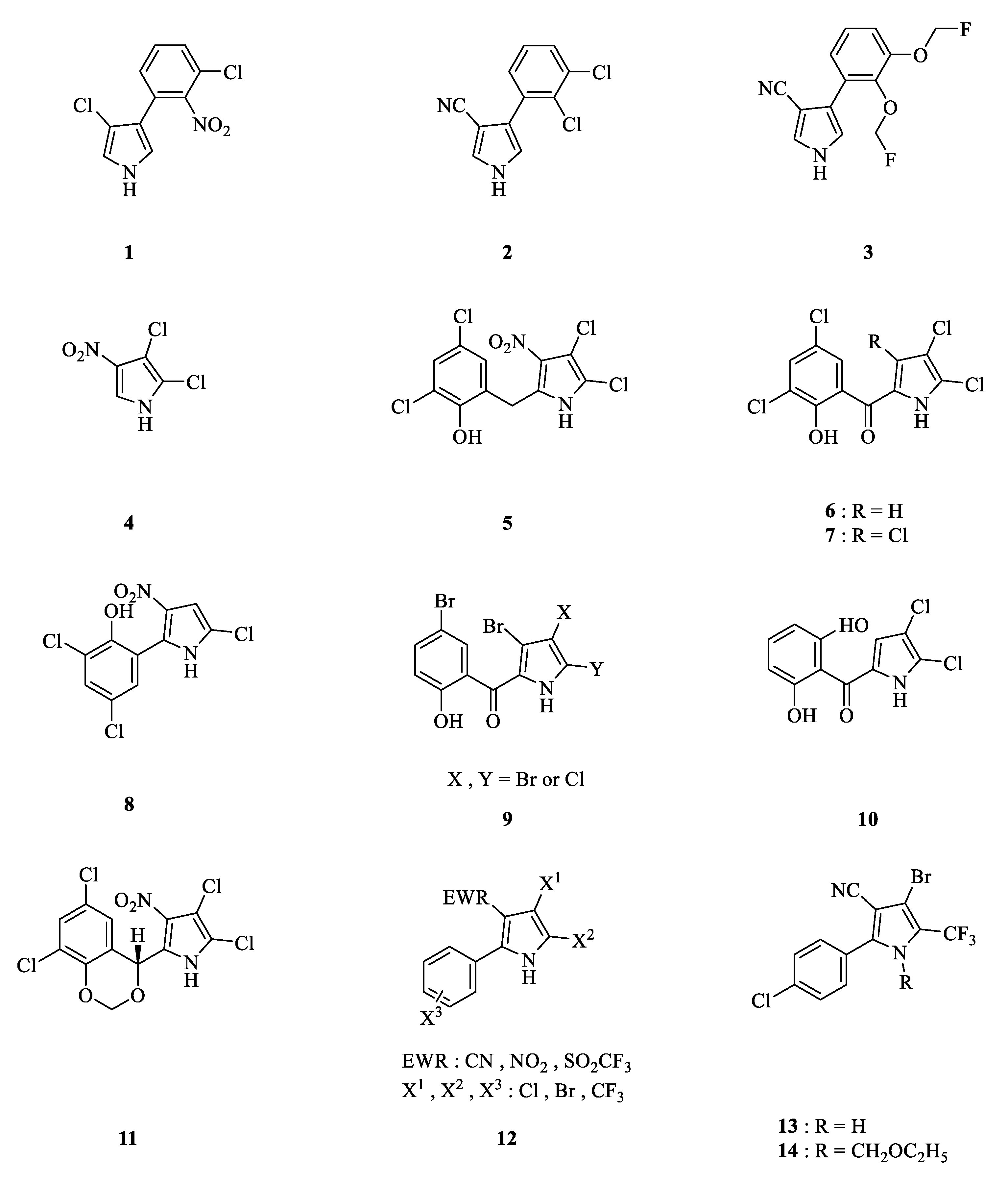


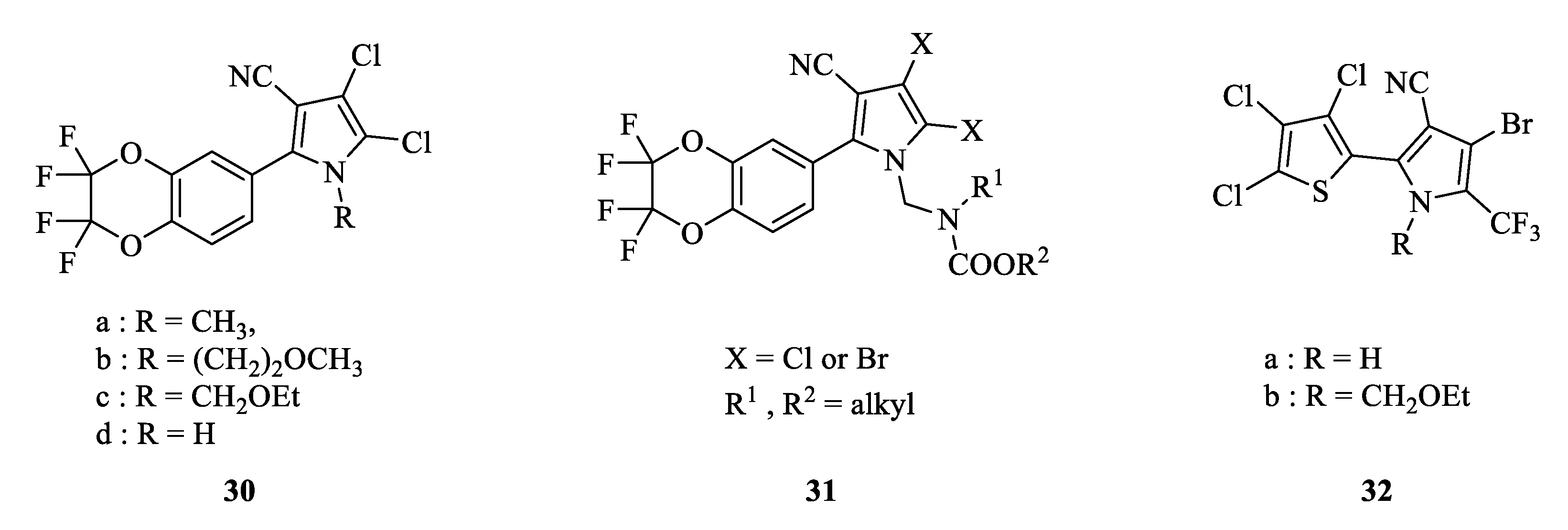

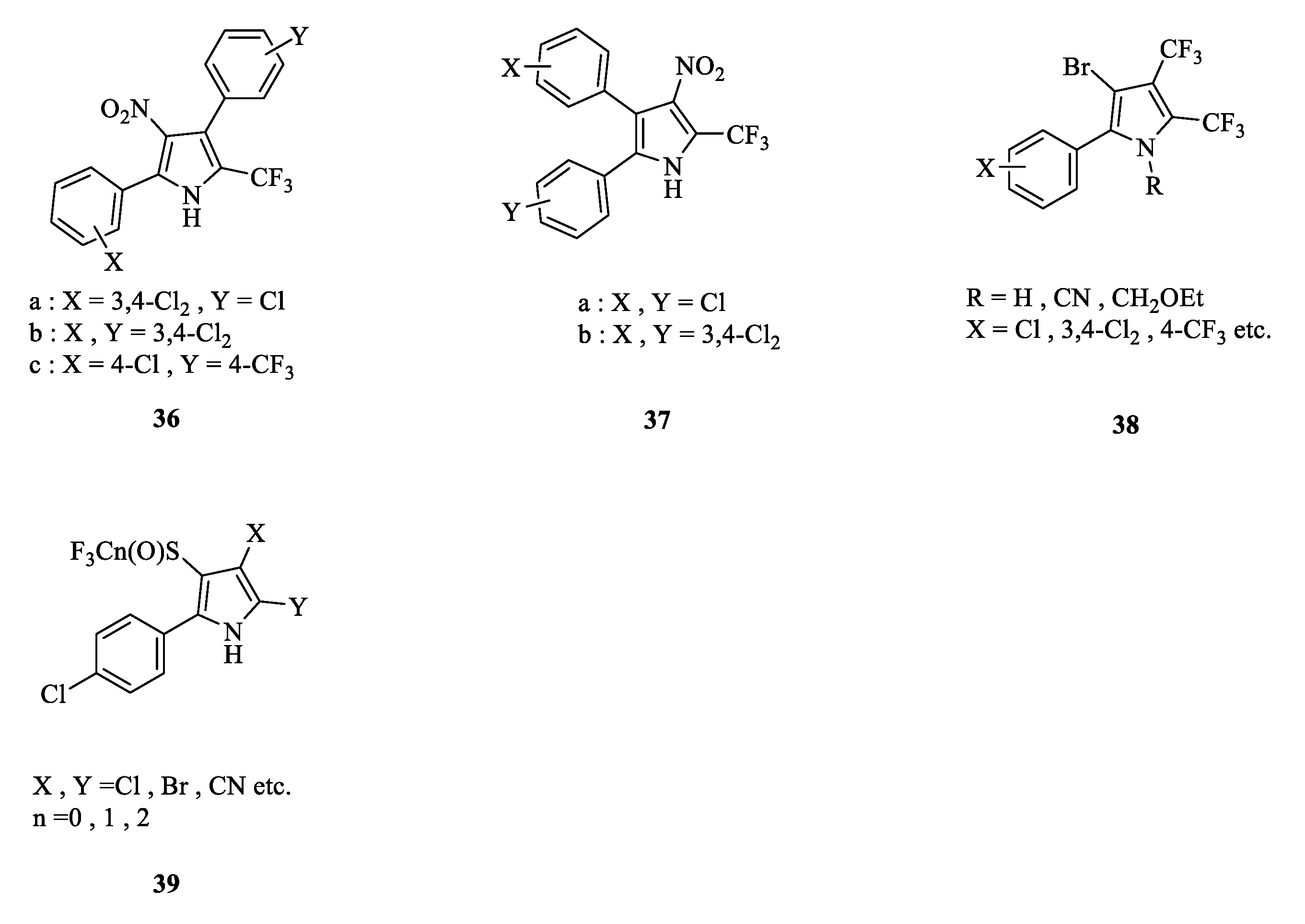
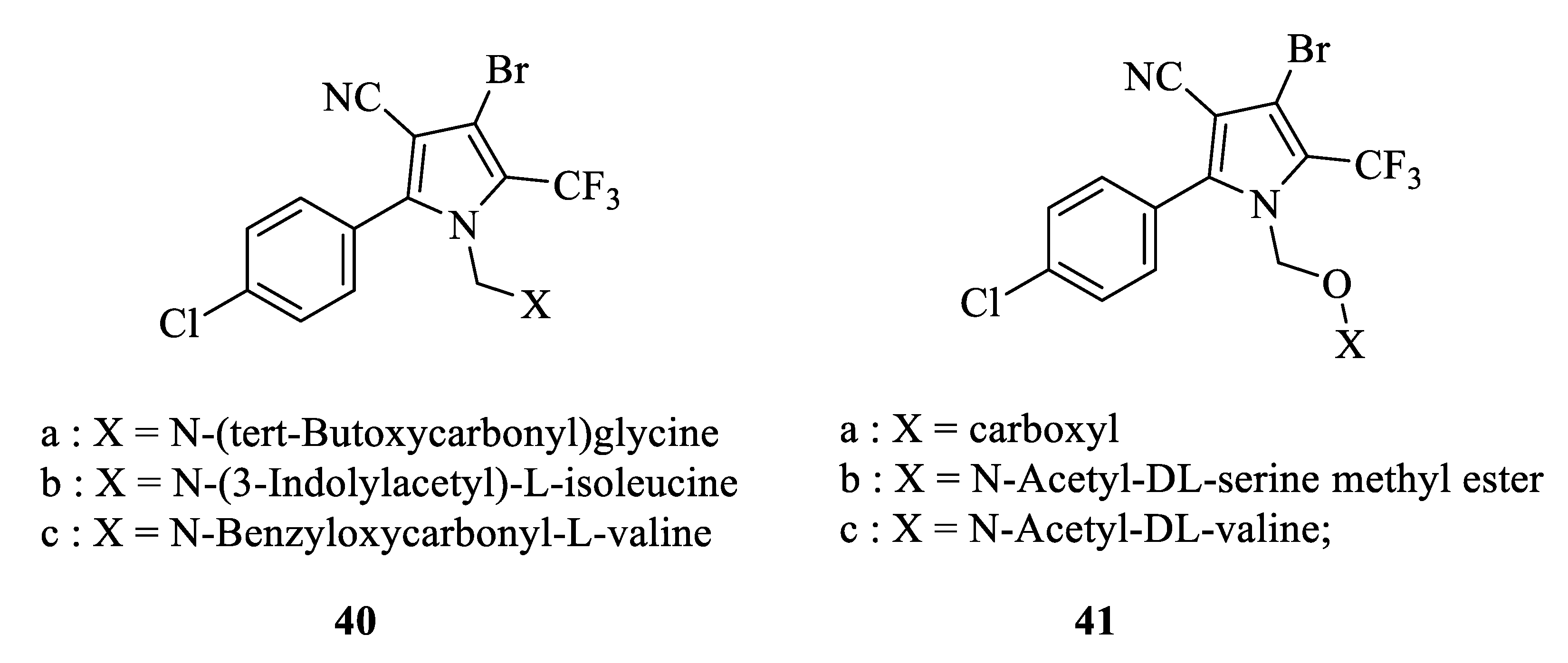
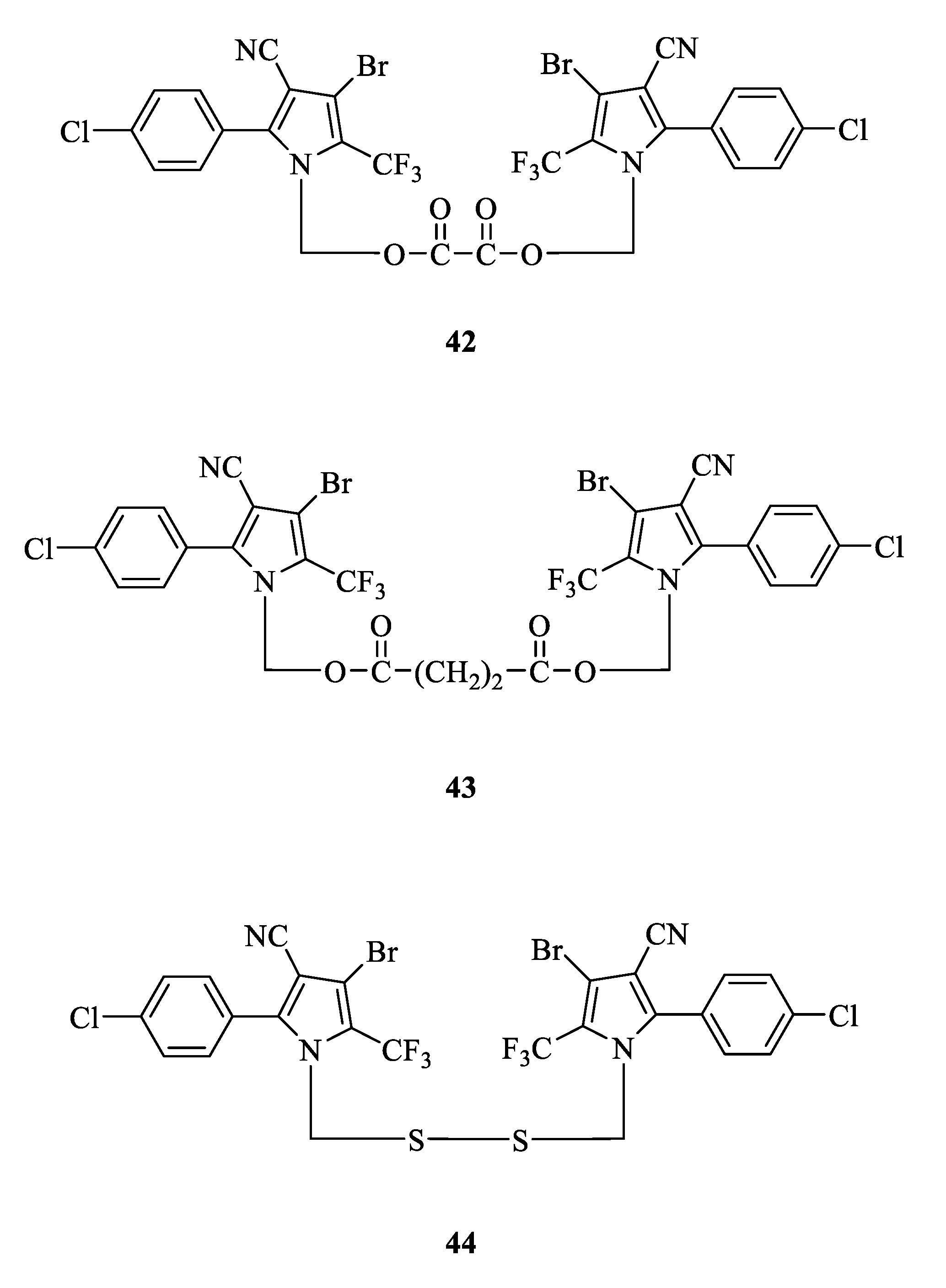



| Compound | Armyworm | Budworm | Mite | Leafhopper |
|---|---|---|---|---|
| LC50 (mg/L) | ||||
| 11 | 40 | 32 | 10 | >100 |
| 13 | 3.5 | 3.6 | 2.9 | 4.9 |
| 14 | 2.6 | 7.5 | 1.6 | 0.92 |
| Raw Materials | Reaction Equation |
|---|---|
| α-P-chlorophenylglycine |  |
| P-chlorophenylglycine and TFAA after lactonization and pyrrole cyclization to obtain arylpyrrolenitrile [2,38,39]. | |
 | |
| P-chlorophenylglycine triethylamine and TFAE after condensation and pyrrole cyclization to obtain arylpyrrolenitrile [40]. | |
 | |
| P-chlorophenylglycine and TFAA with phosphorus trichloride as the catalytic agent after lactonization and pyrrole cyclization to obtain arylpyrrolenitrile [36]. | |
 | |
| P-chlorophenylglycine and TFA with phosphorus trichloride as the catalytic agent after lactonization and pyrrole cyclization to obtain arylpyrrolenitrile [37]. | |
| P-chlorobenzonitrile |  |
| P-chlorobenzonitrile, ethylene glycol dimethyl ether, dimethyl ether, acetonitrile, and potassium tert-butoxide after heating under reflux to obtain the intermediate product. Then, it reacts with 3-bromo-trifluoroacetone to getting arylpyrrolenitrile [41]. | |
| P-chlorobenzyl chloride |  |
| P-chlorobenzyl chloride is added to an ether solution with magnesium flakes and TFAE after the reaction to obtain intermediate product 1. Then, it reacts with hydroxylammonium chloride and sodium acetate to obtain intermediate product 2. Finally, potassium tert-butoxide and β-chloroacrylonitrile are used to obtain arylpyrrolenitrile [42]. | |
| P-chlorobenzylamine |  |
| P-chlorobenzylamine and TFA after acetylation, chlorination, and cycloaddition reaction in the presence of phosphorus trichloride to obtain arylpyrrolenitrile [43,44]. | |
 | |
| P-chlorobenzylamine and methyl trifluoroacetate after reaction in the presence of methanol, phosphorus pentachloride, and acetonitrile to obtain arylpyrrolenitrile [45]. | |
| P-chlorobenzoyl chloride |  |
| P-chlorobenzoyl chloride and triethylamine after acetylation, chlorination, and cycloaddition reaction in the presence of phosphorus trichloride to obtain arylpyrrolenitrile [46,47]. | |
| P-chlorophenylamine acrylonitrile |  |
| Bromine dissolved in carbon tetrachloride reacts with p-chlorophenylaminoacrylonitrile to obtain α-bromo-p-chloro-β-aminoacrylonitrile. Then, it reacts with trifluoroacetone in the presence of acetic acid to obtain arylpyrrolonitrile [35,48]. | |
| α-P-chlorophenyl trifluoroacetamcinonitrile |  |
| α-P-chlorophenyl trifluoroacetylaminonitrile dissolved in toluene reacts with trifluoromethanesulfonic acid to obtain the intermediate product. Then, after the reaction with 2-chloroacrylonitrile, arylpyrrolonitrile is obtained [49]. |
| Classification | Species | Main Results |
|---|---|---|
| Mammal | Rattus norvegicus or Mus muscylus | Chlorfenapyr can seriously damage the DNA of peripheral blood lymphocytes in mice [83]. |
| Chlorfenapyr has strong genotoxicity. Chlorfenapyr can induce DNA breakage damage in spleen, liver, and kidney cells of mice, of which kidney cells are the most sensitive [84]. | ||
| Chlorfenapyr can cause liver damage, and its sub-chronic maximal effect is 25 mg/(kg. d) by mouth [85]. | ||
| Chlorfenapyr can increase external, visceral, and skeletal malformations and alter the tissue ultrastructure [86]. | ||
| Chlorfenapyr has potential genotoxic effects on Chinese hamster ovary (CHOK1) cells, causing chromosome aberrations, micronucleus induction, and DNA strand breakage [87]. | ||
| Canis lupus familiaris | Severe hyperthermia, acute progressive asthma, ataxia, and restlessness occurred after the ingestion of chlorfenapyr [88]. | |
| Acute asthma, vomiting, and subsequent pelvic limb stiffness occurs after the ingestion of chlorfenapyr. Finally, chlorfenapyr leads to collapse and rapid death within 60 to 90 min after these initial clinical symptoms [89]. | ||
| Homo sapiens | The main characteristics of the fatal cases caused by chlorfenapyr poisoning are excessive sweating, renal failure, striated muscle tissue, and fever. Mitochondrial dysfunction is an important component of toxic effects [89]. | |
| The latency period of chlorfenapyr poisoning with delayed toxicity and neurological complications occurred suddenly on or after the 7th day, and death occurred within 24 h [90,91]. | ||
| Chlorfenapyr induces reversible toxic leukoencephalopathy. Although there are survival cases of low-dose poisoning, paraplegia is still caused by the main symptoms of the disease [92,93]. | ||
| Non mammalian | Danio rerio | The acute toxicity of 95% chlorfenapyr against zebrafish is high, with an LC50 value of 0.015 mg/L for 96 h [94]. |
| After treatment with chlorfenapyr at a concentration of 0.2 μg/L and 2 μg/L for 8 days, the bio-enrichment coefficients (BCF8d) of chlorfenapyr in zebrafish were 1211.6 and 1549.7 [94], respectively. | ||
| Chlorfenapyr induces dose-dependent oxidative damage in the liver of zebrafish [80]. | ||
| Bombyx mori | Chlorfenapyr demonstrates certain chronic cumulative toxicity in silkworms, and has an obvious influence on a silkworm’s fecundity [95]. | |
| Chlorfenapyr causes the death of third-instar larvae by blocking molting [96]. | ||
| The acute toxicity of 240 g/L of chlorfenapyr against third-instar larvae is low. The toxicity was enhanced as continuous drug addition continued, which was slower and showed a cumulative effect [97]. | ||
| Anas platyrhynchos | Chlorfenapyr causes metabolic and gastrointestinal disorders, with black contents in the stomach and intestines in ducks [98]. | |
| In ducks, 5 mg/L of chlorfenapyr suppresses their appetite and weakens their foraging ability, which finally leads to death [98]. | ||
| Misgurnus anguillicaudatus or Monopterus albus | Chlorfenapyr has minor acute toxicity against mud eels, with an LC50 value (500 < LC50 < 10 000 mg/L) for 2 d or 4 d [99]. | |
| Chlorfenapyr has minor acute toxicity against loaches, with an LC50 value (500 < LC50 < 10 000 mg/L) for 2 d. However, it has medium acute toxicity against loaches, with an LC50 value (100 < LC50 < 500 mg/L) for 4 d [99]. |
Disclaimer/Publisher’s Note: The statements, opinions and data contained in all publications are solely those of the individual author(s) and contributor(s) and not of MDPI and/or the editor(s). MDPI and/or the editor(s) disclaim responsibility for any injury to people or property resulting from any ideas, methods, instructions or products referred to in the content. |
© 2023 by the authors. Licensee MDPI, Basel, Switzerland. This article is an open access article distributed under the terms and conditions of the Creative Commons Attribution (CC BY) license (https://creativecommons.org/licenses/by/4.0/).
Share and Cite
Huang, P.; Yan, X.; Yu, B.; He, X.; Lu, L.; Ren, Y. A Comprehensive Review of the Current Knowledge of Chlorfenapyr: Synthesis, Mode of Action, Resistance, and Environmental Toxicology. Molecules 2023, 28, 7673. https://doi.org/10.3390/molecules28227673
Huang P, Yan X, Yu B, He X, Lu L, Ren Y. A Comprehensive Review of the Current Knowledge of Chlorfenapyr: Synthesis, Mode of Action, Resistance, and Environmental Toxicology. Molecules. 2023; 28(22):7673. https://doi.org/10.3390/molecules28227673
Chicago/Turabian StyleHuang, Ping, Xiyue Yan, Bo Yu, Xuan He, Lidan Lu, and Yuanhang Ren. 2023. "A Comprehensive Review of the Current Knowledge of Chlorfenapyr: Synthesis, Mode of Action, Resistance, and Environmental Toxicology" Molecules 28, no. 22: 7673. https://doi.org/10.3390/molecules28227673





